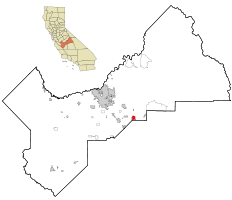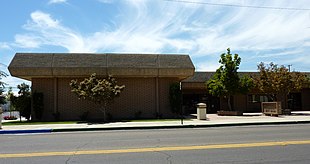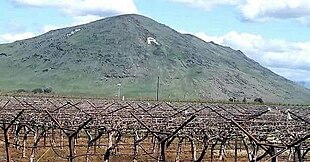Reedley, California | |
|---|---|
| City of Reedley | |
| Nickname: "The World's Fruit Basket"[1] | |
 Location in Fresno County and the state of California | |
| Coordinates: 36°35′47″N 119°27′01″W / 36.59639°N 119.45028°W | |
| Country | United States |
| State | California |
| County | Fresno |
| Incorporated | February 18, 1913[2] |
| Named for | Thomas Law Reed |
| Government | |
| • Mayor | Anita Betancourt |
| • City Council | Matthew Tuttle Suzanne Byers Scott Friesen Mary Fast[3] |
| • State Senator | Anna Caballero (D)[4] |
| • State Assembly | Joaquin Arambula (D)[5] |
| • U. S. Congress | Jim Costa (D)[6] |
| Area | |
• Total | 5.49 sq mi (14.21 km2) |
| • Land | 5.41 sq mi (14.02 km2) |
| • Water | 0.07 sq mi (0.19 km2) 1.39% |
| Elevation | 348 ft (106 m) |
| Population | |
• Total | 25,227 |
| • Density | 4,600/sq mi (1,800/km2) |
| Demonym | Reedleyite |
| Time zone | UTC-8 (PST) |
| • Summer (DST) | UTC-7 (PDT) |
| ZIP code | 93654 |
| Area code | 559 |
| FIPS code | 06-60242 |
| GNIS feature IDs | 1659495, 2410920 |
| Website | www |
Reedley is a city in Fresno County, California, United States. It is located in the San Joaquin Valley, 22 miles (35 km) east-southeast of Fresno,[10] at an elevation of 348 feet (106 m).[8] The population at the 2010 census was 24,194. Its chief economic source is agriculture, particularly fruit and vegetable cultivation and has thus dubbed itself "The World's Fruit Basket".[1] Reedley is situated along the Kings River, downstream from Centerville.
Reedley hosts several cultural festivals, including but not limited to the Reedley Fiesta,[11] and the Electrical Farm Equipment Parade.[12]
Reedley is named for Thomas Law Reed, a Civil War veteran who gave half of his holdings to the township in 1888.[13]
History
[edit]In the mid-1800s, American Civil War Union veteran Thomas Law Reed settled in Reedley to grow wheat for Gold Rush miners. His donation of land for a railroad station site established the town as the center of the San Joaquin Valley's booming wheat industry. Southern Pacific Railroad officials commemorated his donation by naming the depot in his honor, which the city itself then adopted.
When gold mining fever began to fade, wheat demand slackened. Water from the Kings River was diverted for crop irrigation, and the region's agriculture diversified to include fruits, including grapes, figs, and peaches.[14]
With the establishment of water and railroad services, farming families of European immigrants were recruited, and the settlement was incorporated in 1913, with Ordinance No. 1 adopting and prescribing the style of a Common Seal on February 25, 1913.[15] That same year, the city's first cement sidewalks, sewer system, and fire department, as well as the first of two steel water towers were constructed.[16] Because of proximity, the Reedley post office provided rural mail delivery to the surrounding region, including Route 2 which covered a section of nearby Tulare County (about 5 miles west of Dinuba).[17]
A colony of Plautdietsch-speaking Mennonites, who travelled to California to escape the ecological disaster of the Dust Bowl played an important role in the town's early history, settling in Township 8, an area now known as Navelencia. Reedley contains a community of 25 different Christian churches, including Anglican, Catholic, Armenian, Baptist, and Mennonite congregations. The town is also home to a Buddhist temple. The city's cultural influences include Filipino, Finnish, Lebanese, Korean and Japanese immigrants. Since the 1940s, Reedley has seen a large increase in its Hispanic and Latino immigrant population, who have come to represent the majority of Reedley's ethnic makeup.
In 1988, Reedley celebrated the first 100 years since the construction of its Southern Pacific depot, and the 75th anniversary of incorporation. In 2013, the city celebrated its centennial.
Geography
[edit]According to the United States Census Bureau, the city has a total area of 5.2 square miles (13 km2), of which, 5.1 square miles (13 km2) of it is land and 0.1 square miles (0.26 km2) of it (1.39%) is water.
City Buildings and Services
[edit]Reedley National Bank
[edit]
The Reedley National Bank building was built in 1907, when the city was first connected to electricity.[18] The bank has since ceased operation.[when?] The building is situated on 1100 G Street.
Mid Valley Times
[edit]Reedley's downtown is the home of the local newspaper the Mid Valley Times, formerly known as the Reedley Exponent. The Exponent merged with the Sanger Herald and the Dinuba Sentinel in July 2019 in order to improve circulation.[19]
Jansen Opera House
[edit]
The building that houses the Opera House was built in 1903, after a fire destroyed two blocks of downtown Reedley. Danish grain merchant, Jesse Jansen, rallied the downtown shopkeepers to rebuild Reedley's downtown out of brick. The Opera House itself was built at Jansen's personal expense to serve as a cultural and community center. In 1913, the population of Reedley met at the Opera House to vote for incorporation. After the early 1920s, movie houses replaced the popularity of theatre, and the building went into disuse until restoration in 1986. The City of Reedley acquired the building in 2002 by donation.[20]
In 2003, the River City Theatre Company was founded by Mark Norwood, who served as artistic director until his retirement in 2016. The River City Theatre Company currently leases the Opera House and produces musicals and stage plays.[21]
Reedley Municipal Airport
[edit]North of the city and southwest of Mount Campbell, Reedley Municipal Airport (FAA LID: O32) is a public airport, serving southeast Fresno County and northwest Tulare County. There are 21 single-engine aircraft based at Reedley Municipal Airport, and during the 12-month period ending on January 30, 2020, the airport logged 33,000 operations.[22]
City administration and policing
[edit]Government
[edit]Reedley has a Council-City Manager form of municipal government, located at 845 G Street.
Police
[edit]The Reedley Police Department is headquartered at 843 G Street, sharing a building with the city government.
The small communities and area surrounding Reedley are served by the Fresno County Sheriff's Office.
Education
[edit]Kings Canyon Unified School District is a public school system headquartered in Reedley, but also has schools located in the nearby city of Orange Cove, the towns of Dunlap, Miramonte, and the mountain communities. Reedley also offers private educational institutions such as St. La Salle School (Roman Catholic Private K-8) and Immanuel Schools (Mennonite Private K-12). The local community college, Reedley College, offers undergraduate higher education up to an associate degree as well as various certification courses.
Educational institutions in Reedley:
Elementary
- Alta Elementary School
- Jefferson Elementary School
- Great Western Elementary School
- Washington Elementary School
- Lincoln Elementary School
- Immanuel Elementary School
K-8 schools
- Thomas Law Reed K-8 School
- Riverview K-8 School
- Silas Bartsch K-8 School
- St. La Salle Catholic School
Middle schools
- General Grant Middle School
- Navelencia Middle School
- Immanuel Junior High School
High schools
- Reedley High School
- Immanuel High School
- Reedley Middle College High School

Alternative education
- Kings Canyon High School
- Mountain View Independent School
Community college
Demographics
[edit]| Census | Pop. | Note | %± |
|---|---|---|---|
| 1920 | 2,447 | — | |
| 1930 | 2,589 | 5.8% | |
| 1940 | 3,170 | 22.4% | |
| 1950 | 4,135 | 30.4% | |
| 1960 | 5,850 | 41.5% | |
| 1970 | 8,131 | 39.0% | |
| 1980 | 11,071 | 36.2% | |
| 1990 | 15,791 | 42.6% | |
| 2000 | 20,756 | 31.4% | |
| 2010 | 24,194 | 16.6% | |
| 2019 (est.) | 25,658 | [23] | 6.1% |
| U.S. Decennial Census[24] | |||
2010
[edit]At the 2010 census Reedley had a population of 24,194. The population density was 4,693.2 people per square mile (1,800/km2). The racial makeup of Reedley was 14,105 (58.3%) White, 169 (0.7%) African American, 267 (1.1%) Native American, 797 (3.3%) Asian, 8 (0.03%) Pacific Islander, 7,850 (32.4%) from other races, and 998 (4.1%) from two or more races. Hispanic or Latino of any race were 18,455 persons (76.3%).[25]
The census reported that 23,945 people (99% of the population) lived in households, 119 (0.5%) lived in non-institutionalized group quarters, and 130 (0.5%) were institutionalized.
There were 6,569 households, out of which 3,544 (54%) had children under the age of 18 living in them, 3,988 (60.7%) were opposite-sex married couples living together, 946 (14.4%) had a female householder with no husband present, 521 (7.9%) had a male householder with no wife present. There were 440 (6.7%) unmarried opposite-sex partnerships, and 39 (0.6%) same-sex married couples or partnerships. 886 households (13.5%) were one person and 471 (7.2%) had someone living alone who was 65 or older. The average household size was 3.65. There were 5,455 families (83% of all households); the average family size was 3.94.
The age distribution was 7,869 people (32.5%) under the age of 18, 2,797 people (11.6%) aged 18 to 24, 6,594 people (27.3%) aged 25 to 44, 4,627 people (19.1%) aged 45 to 64, and 2,307 people (9.5%) who were 65 or older. The median age was 29.1 years. For every 100 females, there were 104.0 males. For every 100 females age 18 and over, there were 102.7 males.
There were 6,867 housing units at an average density of 1,332.1 per square mile (510/km2), of which 6,569 were occupied, of which 3,881 (59.1%) were owner-occupied, and 2,688 (40.9%) were occupied by renters. The homeowner vacancy rate was 1.8%; the rental vacancy rate was 3.7%. 13,704 people (56.6% of the population) lived in owner-occupied housing units and 10,241 people (42.3%) lived in rental housing units.
2000
[edit]At the 2000 census there were 20,756 people, 5,761 households, and 4,643 families in the city. The population density was 4,700.1 people per square mile (1,800/km2). There were 5,972 housing units at an average density of 1,352.3 per square mile (520/km2). The racial makeup of the city was 51.76% White, 1.73% Black or African American, 1.21% Native American, 8.83% Asian, 37.72% from other races, and 4.44% from two or more races. 57.59% of the population were Hispanic or Latino of any race.[26] There were 5,761 households, 46.8% had children under the age of 18 living with them, 61.5% were married couples living together, 12.9% had a female householder with no husband present, and 19.4% were non-families. 15.8% of households were one person and 8.5% were one person aged 65 or older. The average household size was 3.53 and the average family size was 3.87.
The age distribution was 32.1% under the age of 18, 12.2% from 18 to 24, 29.1% from 25 to 44, 15.2% from 45 to 64, and 11.3% 65 or older. The median age was 29 years. For every 100 females, there were 105.8 males. For every 100 females age 18 and over, there were 104.6 males.
The median income for a household in the city was US$34,682, and the median family income was $37,027. Males had a median income of $30,048 versus $25,495 for females. The per capita income for the city was $12,096. About 18.5% of families and 21.4% of the population were below the poverty line, including 31.6% of those under age 18 and 10.4% of those age 65 or over.
Notable people
[edit]- Charles B. Garrigus, Poet Laureate and state legislator; former professor at Reedley College and Reedley resident
- Kris Holmes, type designer and president of Bigelow & Holmes Inc.
- Lacy Barnes Mileham, Atlanta 1996 Olympics athlete in discus; psychology professor at Reedley College
- Ed Kezirian, UCLA football coach, attended and coached at Reedley College
- Ernestine Gilbreth Carey, author of Cheaper By the Dozen, lived in Reedley
- Paul Hurst, actor, appeared in Gone With the Wind
- Vic Lombardi, Major League Baseball player who pitched for the Pirates and Dodgers; born in Reedley
- Rick Besoyan, singer, actor, playwright, composer, and director of musicals such as Little Mary Sunshine
- Silas Bartsch, former administrator and interim president of Fresno Pacific University; a K-8 public school in southeast Reedley is named in his honor.
References
[edit]- ^ a b "City Council". The City of Reedley. Retrieved April 6, 2013.
- ^ "California Cities by Incorporation Date". California Association of Local Agency Formation Commissions. Archived from the original (Word) on November 3, 2014. Retrieved April 6, 2013.
- ^ "City Council". The City of Reedley. Retrieved January 7, 2022.
- ^ "Senators". State of California. Retrieved April 6, 2013.
- ^ "Members Assembly". State of California. Retrieved April 6, 2013.
- ^ "California's 21st Congressional District - Representatives & District Map". Civic Impulse, LLC. Retrieved April 6, 2013.
- ^ "2016 U.S. Gazetteer Files". United States Census Bureau. Retrieved June 28, 2017.
- ^ a b "Reedley". Geographic Names Information System. United States Geological Survey, United States Department of the Interior.
- ^ "US Census Bureau". www.census.gov. Retrieved August 21, 2024.
- ^ Durham, David L. (1998). California's Geographic Names: A Gazetteer of Historic and Modern Names of the State. Clovis, Calif.: Word Dancer Press. p. 1096. ISBN 1-884995-14-4.
- ^ "Reedley Fiesta kicks off as it celebrates 50 years of the frog jump". KFSN-TV. Reedley, CA. October 12, 2018. Retrieved May 12, 2020.
- ^ "A list of parades and more events to celebrate Christmastime in the Valley". Fresno Bee. Fresno, CA. November 18, 2018. Retrieved May 12, 2020.
- ^ Capace, Nancy (1999). Encyclopedia of California. North American Book Dist LLC. Page 388. ISBN 9780403093182.
- ^ Reedley A Historical Sketch (PDF). Reedley, CA: Reedley Historical Society. pp. 7–9.
- ^ "History". www.reedley.com. Retrieved March 31, 2020.
- ^ "Historical Dates". www.reedley.com. Retrieved September 27, 2016.
- ^ Cornelius Cornelius Harms in the U.S., World War II Draft Registration Cards, 1942. Accessed via ancestry.com paid subscription January 26, 2023.
- ^ "Reedley Historical Dates". The City of Reedley. Retrieved May 12, 2020.
- ^ "Mid Valley Times". Mondo Times. Mondo Code LLC. Retrieved May 12, 2020.
- ^ "History of The 1903 Jansen Opera House". Reedley's River City Theatre.
- ^ "History of The 1903 Jansen Opera House". Reedley's River City Theatre.
- ^ AIRPORT MASTER RECORD (Report). U.S. Department of Transportation Federal Aviation Administration. April 23, 2020. p. 1.
- ^ "Population and Housing Unit Estimates". Retrieved May 21, 2020.
- ^ "Census of Population and Housing". Census.gov. Retrieved June 4, 2015.
- ^ "2010 Census Interactive Population Search: CA - Reedley city". U.S. Census Bureau. Archived from the original on July 15, 2014. Retrieved July 12, 2014.
- ^ "U.S. Census website". United States Census Bureau. Retrieved January 31, 2008.
External links
[edit]- Official website

- ReedleyAirport.com Reedley Municipal Airport
- KingsCanyonUnified.com School District Homepage
- SierraKingsHospital.org Local Hospital






